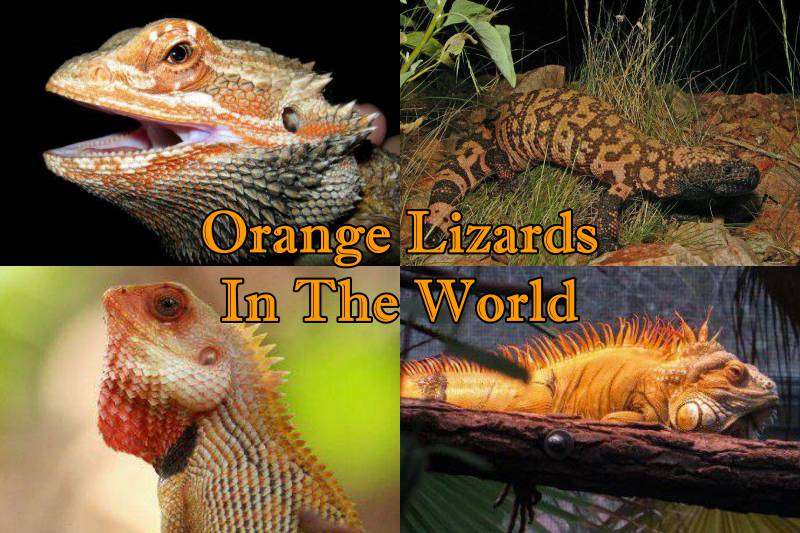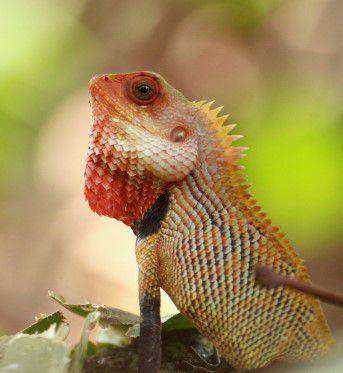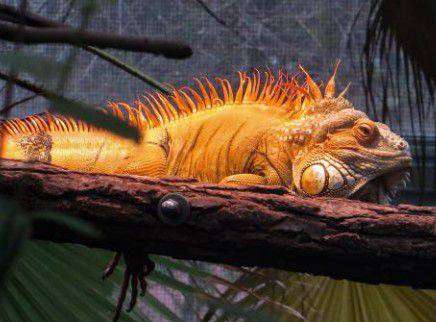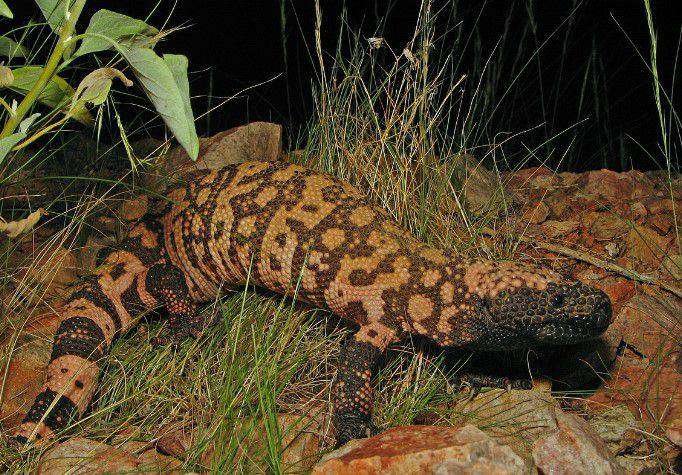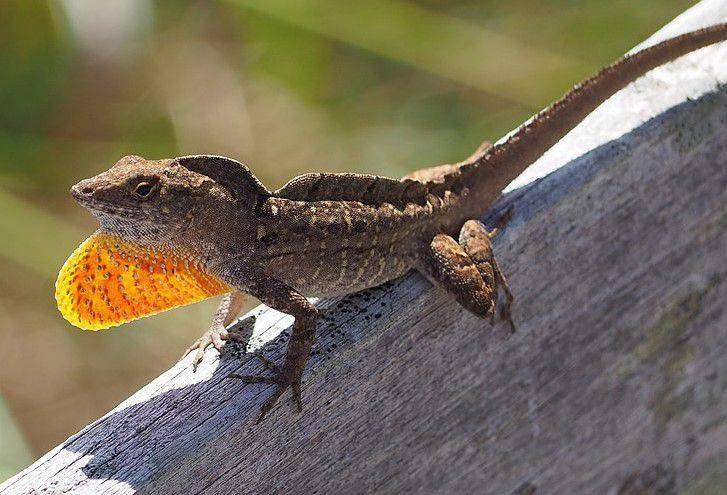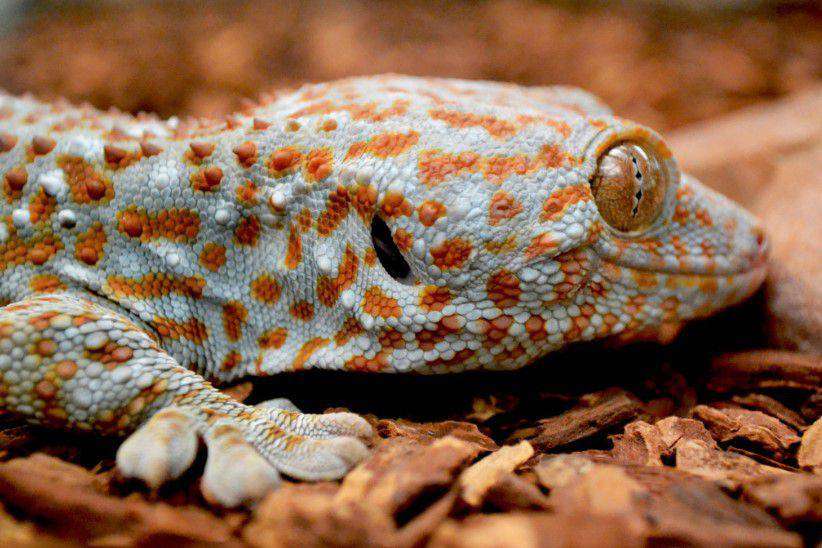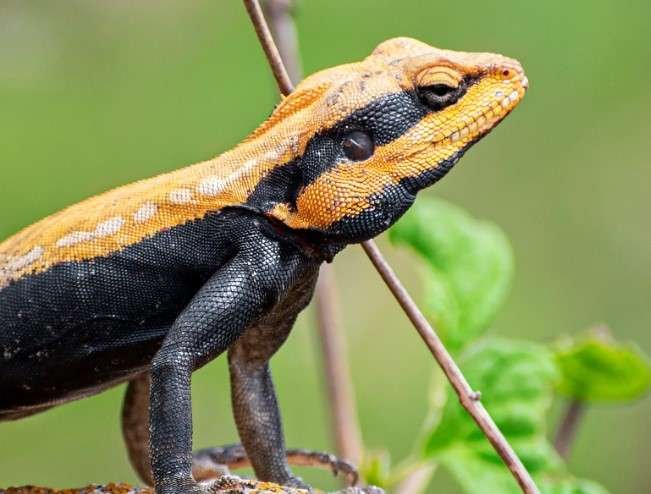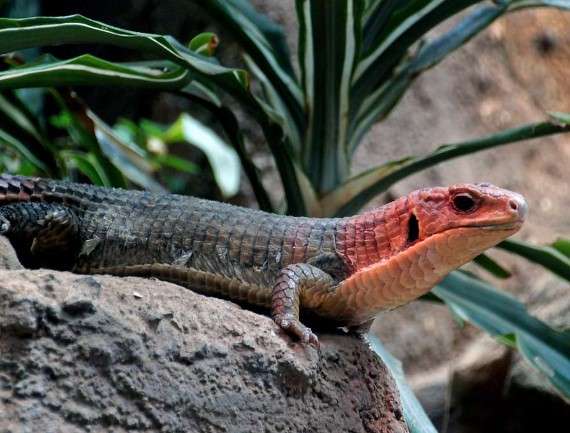With almost 7000 discovered species, lizards are one of the most diverse groups of reptiles on the planet. Diversity is not only restricted to physical appearance and features but also foraging habits and diet. If you have a backyard or a lawn, then these creatures become regular visitors. You might catch one munching on some insects or fruits, or simply basking in the sun. Lizards have body colorations that help in inter and intra-specific differentiation. In today’s list, we are going to talk about 15+ Orange Lizards in the World.
15+ Uncommon Orange Lizards
1. Bearded Agama
- Scientific name: Pogona vitticeps
- Size: 24 inches (including tail)
- Location: Arid and Semi-Arid regions of Australia
Bearded Dragons occur in various colorations of brown, red, yellow, white, and particularly orange. They are capable of experiencing slight color shifts. A bearded dragon will flatten its body on the ground, puff its spiky throat out, and its jaws open up to appear larger when it feels threatened.
The pouch-like protrusion on the underside of the neck is what gives the bearded dragon its name. The lizard’s dorsal skin darkens in the presence of light and lightens under dark conditions.
2. Oriental Garden Lizard
- Scientific name: Calotes versicolor
- Size: 14 inches
- Location: India, Malaysia, Bangladesh, Cambodia, Sri Lanka
In the second position of this list of Orange Lizards, we have the Oriental Garden Lizard, popularly known as Raktochosha (Bloodsucker) in the state of West Bengal, India. The characteristic feature of this lizard is its tails, which may grow as long as 11 inches n some specimens.
The coloring varies greatly; at times it is consistently brownish, greyish-olive, or sometimes orange to yellow. The shoulders of the males turn bright orange to crimson and his throat turns black during the mating season. In addition, males develop red or orange heads after defeating opponents.
3. Orange Green Iguana
- Scientific name: Iguana iguana
- Size: 1.2-1.7 meters
- Location: North and South America
The Green Iguana is one of the largest herbivore species of arboreal lizards. Though it is known as Green Iguana, it occurs in several colorations like green, bluish, and even reddish-brown.
However, the Mexican species and others from the Northern Ranges have orange colorations, which brings them up on this list. Green Iguanas have a whip-like tails, with which they can deliver highly painful strikes.
Iguanas have quite a sharp vision, and they can even perceive UV. Due to their several colorations and despite being an invasive species in many states of the US, Iguanas are gaining worldwide popularity as good indoor pets.
4. Gila Monster
- Scientific name: Heloderma suspectum
- Size: 20 inches
- Location: Southwestern US, Northern Mexico
Next up on this list of Orange Lizards, we have the largest North American extant lizard, we have the Gila Monster. It is a large, generally lethargic reptile that rarely offers a genuine threat to people because of its sluggish temperament and heavy build.
Little pearl-shaped bones can be found in the scales of the head, back, and tail (osteoderms). These have pink or orange or both along the backs of their black bodies.
Gila Monsters are venomous lizards. When they bite, the capillary actions bring out the venom through grooves in their teeth, which conduct the venom into the animal’s flesh.
5. Brown Anole
- Scientific name: Anolis sagrei
- Size: 5-8.5 inches
- Location: Bahamas, Cuba, the United States
You might be thinking why the name Brown Anole is on this list of Orange Lizards, right? Well, the Brown Anole mostly occurs in light brown tints, with some distinctive markings on the sides and back.
Though they can change color, Brown Anoles do not turn orange. What puts them on this list is the color of their dewlap. A loose hanging longitudinal flap of skin, below the jaws, the dewlap is primarily orange in color. The hue ranges from yellowish-orange to reddish-orange.
6. Frilled Lizard
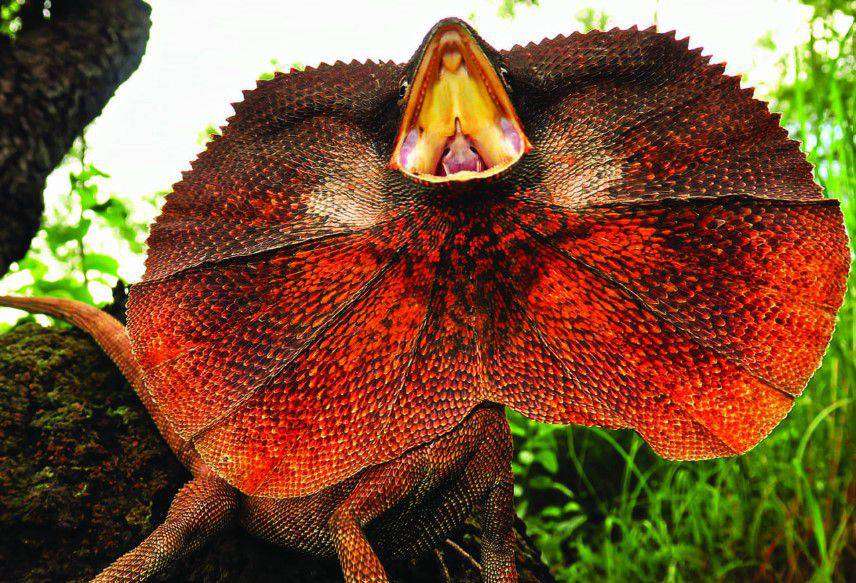
- Scientific name: Chlamydosaurus kingii
- Size: up to 3 feet
- Location: endemic to Northern Australia and also southern Guinea
In the sixth position on this list of Orange Lizards, we have the Frilled Lizard. They get their name from a frill, which is a skin flap that remains folded into ridges.
When a predator or a competitor threatens it, the frill opens up and extends around the next like a disc to scare away predators. Frills have multiple colorations, red, orange, yellowish, and white.
Frilled Lizards have a body color that ranges from reddish-orange to a darker tone, and sometimes even olive green.
7. Tangerine Leopard Gecko
- Scientific name: Eublepharis macularius
- Size: 7-11 inches
- Location: India, Pakistan, Nepal
Leopard geckos are one of the most popular pet lizards in the world. Coming in all spectrum of coloration, from yellow to brown, they have white spots all over their dorsal body.
Tangerine leopard geckos are quite popular due to their orange color. Selective breeding may cause their white spots to disappear completely. The color orange comes primarily from two chromatophores, xanthophores, and erythrophores.
While the former is responsible for the yellow color, the latter brings about the red color. Like all leopard geckos, Tangerines also have a fatty tail, that stores food in the form of fats, that they can use during times of distress.
8. Tokay Gecko
- Scientific name: Gekko gecko
- Size: 10-12 inches
- Location: Southeast Asia
In the next position, we have the third largest Gecko species, the Tokay Gecko. Quite a distinctive lizard, their granular skin has a grayish base coloration with bright orange speckles all over the body.
Tokay Geckos, with their broad heads and strong jaws, can deliver powerful bites. They feed mainly on invertebrates and even on other smaller geckos and lizard species.
Its colorations have made it one of the most popular gecko pets, and its use in traditional medicine has caused its indiscriminate hunting in China and Indonesia.
9. Flame Crested Gecko
- Scientific name: Rhacodactylus ciliates
- Size: 5-7 inches
- Location: New Caledonia
Among the three Crested Gecko variants, the Flame Crested Gecko is primarily known for its coloration. Bearing the name Tiger Crested gecko, this Crested Gecko variant comes in an orange hue and several shades.
Individuals in the wild show a pale coloration, but captive-bred ones are somewhat vibrantly colored due to selective breeding. Crested Geckos were an extinct species until its rediscovery in the year 1994 and are currently under the CITES protection as a vulnerable species.
10. Plestiodon laticeps
- Size: 6- 13 inches
- Location: South Eastern United States
Juveniles have brown or sometimes black bodies that have stripes ranging from five to seven stripes in number on the dorsal side. These stripes vary in coloration from white to sometimes light orange, gradually transitioning to a vivid blue on the tail.
Males lose all their stripes by the time they reach sexual maturity, becoming a solid shade of brown. Mature males get bigger oranges and grow in size and vibrancy, and are equipped with powerful jaws.
11. Western Pilbara Spiny-Tailed Skink
- Scientific name: Egernia cygnitos
- Size: 14 centimeters
- Location: Pilbara, Northwestern Australia
In the 11th position on this list of Orange Lizards, we have the Western Pilbara spiny-tailed skink. Skinks in general are lizards with stout bodies that have spiny tails, muscular legs, and long toes that help them grasp onto rough surfaces.
Since they inhabit the arid and semi-arid regions of Australia, they have various morphological modifications to counter the water loss. The scales on their skins are rough-edged which minimizes water loss, by covering the thick skin underneath.
These lizards are orange to brown in coloration, with black spots etched on the surface. Like most skins, they too have thick tails.
12. South Indian or Peninsular Rock Agamas
- Scientific name: Psammophilus dorsalis
- Size: 135 mm in length.
- Location: Majorly found in Indian states, Rocky Hills in South India
The Peninsular Rock Agamas are a type of garden lizard that is strikingly colored in orange and black. They are found in rocky scrub areas and warm spots. These orange lizards cannot generate their own body heat, so they usually bask on bare rocks or stony walls.
They are insectivorous in nature and are of great ecological importance because they can indicate how the food web is changing. Though the females and juveniles in these species are dull in color, the males have brilliant bright colors, including orange, in the breeding season.
They defend themselves from bird predators by flattening its body on their ground by camouflaging themselves with surrounding rock.
13. Common Butterfly lizard
- Scientific name: Leiolepis belliana
- Size: 18 cm (7.1 inches)
- Location: Thailand, Vietnam, Cambodia, Malaysia, and Indonesia.
As their name suggests, they’ve beautiful flanks on their sides. They have a polygonal net-like pattern with yellow color spots on their backs and beautiful small-striped lines of orange and black color on their flank.
They are found in open areas such as disturbed agricultural land and open, flat, sandy areas with tropical lowland forests to bask directly. Their diet consists of grasshoppers, butterflies, crabs, beetle larvae, and other insects.
14. Spiny-Tailed lizard
- Scientific name: Uromastyx (sp. ornate, saharan, geyri, etc.)
- Size: 25-91 cm or 10-36 inches
- Location: North and Northeast Africa, the Middle East, ranging as far east as Iran. Also found in the Thar desert.
They change their color according to the temperature and season. They can appear dark and dull during cool weather but become lighter in warmer seasons and can take on an orange color. Their darker pigmentation helps them bask more efficiently.
Their stout tail is muscular and heavy, armed with numerous protective spines, and able to be swung to frighten their predators. They are predominantly herbivorous and eat plant vegetation and animal matter.
They inhabit rocky, warm, and dry habitats. These orange lizards hide in burrows as a part of their behavioral adaptation for maintaining a constant body temperature. They are also known to be sneezing ‘salt.’
15. Broadhead Skink
- Scientific name: Plestiodon laticeps
- Size: 15-33 cm (6-13 inches)
- Location: Southeastern United States
They have wide jaws and triangular heads. Adult males are brown or olive-brown in color and have bright orange-red swollen heads during the mating season in the spring.
They are arboreal and seek shelter under foliage. They’re also very beneficial for the gardens, as they’re insectivorous and also feed on cockroaches, snails, and even small mice.
16. Yellow-Headed Gecko
- Scientific name: Gonatodes albogularis
- Size: 69-90 mm (2.7-3.5 inches)
- Location: parts of Central and South America, Cuba, Hispaniola, and Jamaica.
They are sexually dimorphic. The males are colorful with yellow to orange color heads, but the females are dull and greyish in color. They prefer to live in tropical dry forest habitats. They’re very territorial lizards and feed on spiders and insects.
Now, we come to the end of our today’s article, 15+ Orange Lizards in the World. We will be back with many such interesting articles, until then you can browse through write-ups on a wide variety of niches.
References
Animal Diversity Web- Broadhead Skink
Evolution Reptile- Flame Crested Gecko
Smithsonian’s National Zoo- Gila Monster
SREL Herpetology- Brown Anole
Mark O’Shea; Lizards of the World
Also Read:

A zoology student turned writer. Nature has always been a magnet to me, and to unearth some of its secrets through my articles is my prime intention. If not engaging myself with nature and anime content, you can always find me going through some Bengali classics or filling the air with some soulful Tabla beats. An artist, trying to throw some colors to my blank canvas of life.
